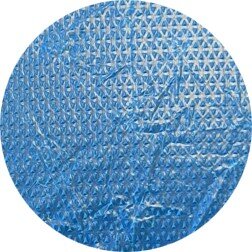The primary purpose of any cleanroom shoe cover is to reduce footborne contamination in a cleanroom. Most shoe cover materials are engineered to encapsulate particles for this reason. Your cleanroom apparel material may also include features such as chemical resistance, controlling electrostatic discharge (ESD), and durability.
There are also safety factors to consider when selecting the appropriate substrate. One important factor that can be overlooked, especially in cleanrooms with normally dry processes, is non-skid soles to keep operators safe and secure in the event of a wet floor from a spill. Operator stability and security contribute to overall operator comfort – and a happy operator is a productive operator.
With operator safety and comfort in mind, let’s look at some shoe cover fundamentals including the types and performance of shoe cover and sole materials.
Most Shoe Cover Substrates Perform Well at Controlling Contaminants
Your cleanroom shoe covers, whether disposable or reusable/washable, should be made from lint-free, synthetic materials to minimize the release of particles from operator footwear that can contaminate the cleanroom environment.
For disposable shoe covers, common substrate materials include:
Polypropylene (PP)
Polypropylene is made from spunbond polypropylene that encapsulates larger particles. This nonwoven, lightweight, breathable fabric provides a low-cost solution for protection against dry, larger particulates. However, in wet conditions, the material’s absorbency causes the shoe cover to break down, release particles, and become slippery.
Crosslinked Polyethylene (CPE)
Crosslinked Polyethylene in low density is impervious to liquids, lint-free and does not run or bleed when exposed to water. From this standpoint, CPE is ideal for shoe covers from a cleanliness perspective but can become exceedingly slippery in wet conditions.
Polyethylene coated polypropylene (PCPP)
Polyethylene coated polypropylene is polypropylene but with a polyethylene coating. PCPP is also impervious to liquids, lint-free, and has excellent tensile and tear resistance. It protects workers exposed to splashes from certain chemicals, liquids, and particulates, and is exceptionally durable for a limited-use disposable footwear option.
PP, CPE, and PCPP all perform quite well at their basic purpose: controlling foot borne contamination Depending on your environment and process, your selection will need to meet your specific requirements for cleanliness, liquid resistance, and durability. However, one of the most overlooked requirements is operator safety and non-skid features.
The Sole of The Matter: Operator Safety
In 100% dry critical environments, these shoe cover substrates are all relatively stable and provide secure footing for the operator. In critical environments with wet processes, or when spills occur in dry environments, shoe covers might not only pose a risk of contamination but also become a trip/fall hazard for operators on certain floor types.
All substrates reviewed here lose “tack” to varying degrees when wet and put operators at risk of falling and injury. The industry standard and ASTM measurement for traction is the coefficient of friction (ASTM D1894). To increase the coefficient of friction of shoe covers for dry or wet floors, manufacturers add coatings, treatments, or different materials to the sole.
Let’s review the advantages and disadvantages of common sole coatings, treatments, and substrates:
Anti-skid Coatings
Latex coatings are commonly added to the bottom of polypropylene (PP) shoe covers in a tread-like pattern to increase traction on dry floors. This anti-skid coating works well in dry environments but if the PP substrate becomes wet, it will absorb the liquid and reduce traction. Additionally, the anti-skid coating can lose its effectiveness through wear and tear during a shift, reducing its coefficient of friction. Operators may not feel stable and secure, especially near a spill.

Embossed Tread Patterns
For substrates like CPE, a tread pattern can be stamped onto the material itself to improve traction on a dry floor. Since CPE is impervious to liquids, liquids between the bottom of the shoe cover and a smooth floor act as a lubricant, becoming slippery and unsafe for the operator. In wet conditions, the coefficient of friction decreases drastically.
 PVC Textured Soles
PVC Textured Soles
The best solution for increased coefficient of friction and operator safety in a shoe cover is to stitch in a custom sole made of PVC (vinyl). When the sole of a limited-use shoe cover is replaced with a PVC substrate and stamped with a dimpled waffle texture, it uniquely improves the coefficient of friction in both dry and wet conditions. The PVC material is durable, clean, impervious to liquids, and slip resistant on every floor type and application scenario. Unlike the rigid, molded soles that are standard on launderable shoe covers, a PVC sole offers a sleeker profile, allowing for a more secure and snug fit. This reduces trip hazards while maintaining durability. The PVC sole material is integrated and stitched into the upper shoe cover substrate—most commonly PCPP—resulting in a clean, safe, durable option that overcomes many of the trade-offs common to most shoe covers.
What About Launderable Shoe Covers with Molded Soles?
For these types of shoe covers, the substrate adheres to a rigid sole, often with a lip that curves up from the bottom. Shoe covers with molded soles can have superior durability and are usually washable. However, they may be ill-fitting and add cumbersome bulk to the foot, posing a trip hazard in dry conditions.
In addition, the rigid sole can make it difficult to ensure a snug fit at the ankle or leg cuff band. In wet conditions, molded soles are slippery with a low coefficient of friction. Operators may not feel stable and secure in molded shoes in dry or wet conditions.
Operators Prefer the Grip And Fit of PVC Soles
While many large-scale facilities incorporate PP and CPE shoe covers as undergarments and rely on launderable, molded sole shoe covers for operating inside the cleanroom, an increasing number of facilities with slip/fall risks have converted exclusively to a PVC sole shoe cover.
The unique construction eliminates slip hazards on all floor types (wet or dry), mitigates trip hazards common to molded soles, and is durable enough for extended/multi-shift use. The PVC sole—available in both shoe cover and boot cover styles—is the leading solution for cleanroom operator safety providing slip resistance and a secure fit on all floor types.
EXPLORE MORE RESOURCES
Cleanroom Apparel Selection Fundamentals Part 1: What You Need to Know
Cleanroom Apparel Selection Fundamentals Part 2: Cleanliness and Application Requirements
Cleanroom Apparel Selection Fundamentals Part 3: Four Steps to Close the Cleanliness-Comfort Gap in Cleanroom Apparel

Valutek
Valutek is one of the first and few manufacturers to offer a full product portfolio of best-in-class cleanroom products. Since 1988, our controlled environment consumables are helping leading organizations operate their cleanrooms in a consistently stable state.
Related Articles
- Valutek

- 26 October 2023
Comfortable, Happy Operators Reduce Risk of Contamination
Your organization’s cleanliness requirements for cleanroom gloves, gowns, caps, and face coverings...
- Valutek

- 27 July 2023
Four Steps to Close the Cleanliness-Comfort Gap in Cleanroom Apparel
There are trade-offs between cleanliness and comfort when it comes to cleanroom apparel. The ...
- Valutek

- 20 December 2023
Cleanroom Documentation Selection Fundamentals: Paper, Notebooks and Notepads
Paper is used daily in controlled environments to document work instructions, manuals, job orders,...



